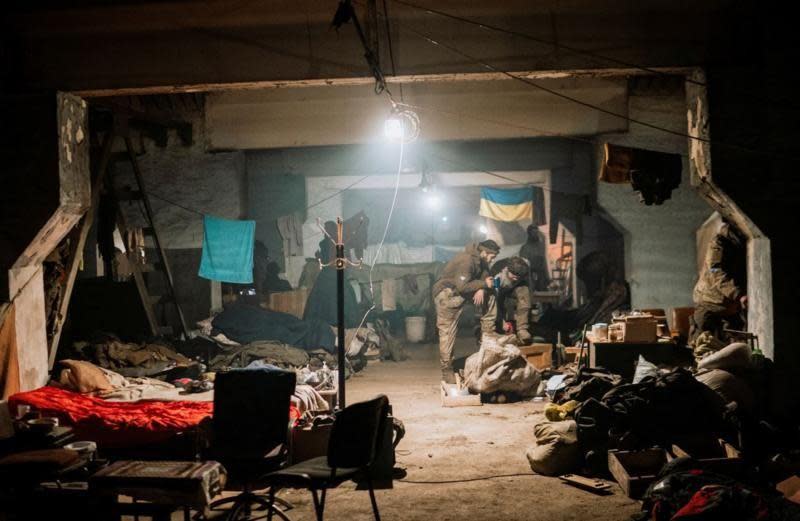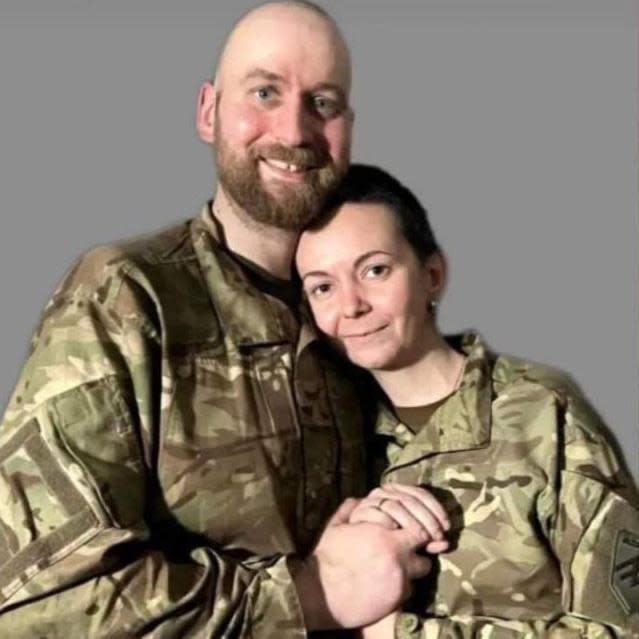Mariupol was doomed. Relentless Russian shelling turned streets into ruins and courtyards into cemeteries.
But several meters underground, in the southeastern Ukrainian city, a romance was blossoming.
Valeria Subotina, 33, was sheltering in the huge Azovstal steelworks, the city’s last stronghold, when it was surrounded by Russian forces in the spring of 2022.
She had taken shelter in one of dozens of Soviet-era bomb shelters built to withstand nuclear war, deep below the industrial plant.
“You go down a half-collapsed staircase, go through passages and tunnels and go down further and further. Finally you arrive at this concrete cube, a room”, says Valéria.
In the bunker – alongside soldiers and civilians – Valeria worked with the army’s Azov brigade as a press officer, communicating the horrors of the months-long siege of Russia to the global media.
There was also her fiance, Andriy Subotin, a 34-year-old Ukrainian army officer, defending the plant.

The pair met through work – the Mariupol Border Guard Agency – about three years before the siege.
When Andriy met Valeria, it was love at first sight.
“He was special, it was so warm to be around him,” says Valeria. “He was always kind and never refused to help anyone.”
Andriy was an optimist, she says. He knew how to be happy and found joy in small things: the sun, smiles, the company of friends.
“The first day we met, I realized that Andriy was very different from the others.”
Within three months, they moved in together, renting a small one-story house in Mariupol with a garden. The couple began to build a life together.
“We traveled a lot, we went to the mountains, we met friends”, says Valéria.
“We fish together and spend a lot of time outdoors. We visit theaters, concerts and exhibitions. Life was full.
They decided to get married and dreamed of a big church wedding with family and friends. They chose wedding rings.
Valeria quit her job and began to nurture her creative side, writing and publishing poems about the early years of fierce fighting with Russia in Mariupol.
“For a few years, before the full-scale invasion, I was truly happy,” she recalls.
Everything changed in February 2022.
Spring brought sunshine to Valeria and Andriy’s garden and the first flowers were appearing.
“I was starting to enjoy spring,” says Valeria. “We knew about Putin’s threats and realized there would be a war, but I didn’t want to think about it.”
A few days before February 24, the day the full-scale invasion began, Andriy urged Valeria to leave the city. She refused.
“I knew that no matter what happened, I had to be in Mariupol, I had to defend my city.”
Weeks later, they were both underground, in the Azovstal bunkers.
They only saw each other occasionally, but when they did it was moments of “pure happiness”.


At this point, Mariupol was approaching a humanitarian catastrophe.
Infrastructure strikes cut off water and power supplies to parts of the city and there were food shortages. Houses and civilian buildings were also destroyed.
On April 15, a large bomb was dropped on the plant. Valeria narrowly escaped death.
“I was found among corpses, the only one alive. On the one hand, a miracle, but on the other, a terrible tragedy.”
She had to spend eight days in an underground hospital at the factory with a severe concussion.
“The smell of blood and rot was everywhere,” she says.
“It was a very scary place where our injured comrades, with amputated limbs, were lying everywhere. They couldn’t get adequate help because there were few medical supplies.”
Andriy was deeply worried about Valeria after her injury and began planning a wedding right there in the bunker.
“It seemed like he was in a hurry, as if we didn’t have any more time,” says Valéria.
“He made some wedding rings out of aluminum foil with his own hands and asked me to marry him. Of course, I said yes.
“He was the love of my life. And our rings made out of aluminum foil – they were perfect.”


On May 5, the couple married a plant commander. They held a ceremony in the bunker, using their uniforms as their wedding attire.
Andriy promised his wife that they would have a decent wedding when they returned home, with real rings and a white dress.
Two days later, on May 7, he was killed in action at the steel mill, by Russian bombing.
Valeria didn’t find out right away.
“People often say you feel something inside when a loved one dies. But I, on the contrary, was in a good mood. I was married and in love.”
One of the hardest things was having to endure a “lump of pain” while defending your city alongside “your boys” – comrades – in Azovstal.
“I was a bride, I was a wife and now I am a widow. The scariest word,” she says.
“I couldn’t react the way I wanted to at that moment.
“My boys were always around. They sat next to me, slept next to me, brought me food and supported me,” she says. “I could only cry when they weren’t looking.”
At one point, it seemed like the fear of being in the war zone was eased by his pain.
“I didn’t care anymore… You just understand that there are many more people waiting for you in the next world, if it exists, than here with you.”
Ukrainian soldiers in Azovstal finally surrendered on May 20. Valeria found herself among 900 prisoners of war forcibly taken by the Russian military out of Mariupol.
“We looked out the bus windows at those buildings we loved, at those streets we knew so well. They destroyed and killed everything I loved – my city, my friends and my husband.”
Valeria survived 11 months of Russian captivity and told of torture and abuse. Andriy often appeared in her dreams.
In April last year, she was released as part of a prisoner exchange and is now back in Ukraine.
It is difficult to say how many people were killed as a result of the Russian shelling of Mariupol, but local authorities say the number exceeds 20,000.
According to the UN, 90% of residential buildings were damaged or destroyed and bodies still lie in the rubble.
As far as Valeria knows, her husband’s body remains at the Azovstal steelworks in the now occupied city.
Sometimes, she says, she looks up at the sky and talks to it.






































